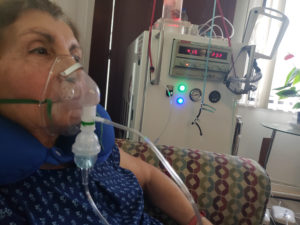 Airborne viruses enter our lungs by breathing. Viral contagions can cause inflammation that obstruct both air exposure and gas exchange of the capillaries inside the lungs. The pathology of COVID-19 have revealed patients exhibited edema (fluid accumulation that obstructs pulmonary gas exchange), proteinaceous exudate (chronic wound of blood vessels allowing passage of solid matter into the lungs), and other cellular morphological damage including fibrosis (scarring of the lung tissue).
Airborne viruses enter our lungs by breathing. Viral contagions can cause inflammation that obstruct both air exposure and gas exchange of the capillaries inside the lungs. The pathology of COVID-19 have revealed patients exhibited edema (fluid accumulation that obstructs pulmonary gas exchange), proteinaceous exudate (chronic wound of blood vessels allowing passage of solid matter into the lungs), and other cellular morphological damage including fibrosis (scarring of the lung tissue).
We think the way a virus enters the body’s respiratory system by gas (air) transfer is key to changing the treatment paradigm. Inhalation of DiTetra Gas with a high redox potential can change the environment of the pulmonary area to make it less favorable for virus survival and reduction of inflammation to sustain gas exchange in the lungs. DiTetra Gas works without any added pressure to allow the lungs to work on their own and breathe normally.
Ventilators Are Not For Recovery … But There is a Technology Design Answer
Ventilators are mechanical machines with adjustable pressures that move breathable air into and out of the lungs … giving life-supporting breathes to patients who have either lost their function to breathe or breathing insufficiently for sustainable oxygen levels in the blood. Sadly for the terminal condition, the lungs will ultimately stop moving on their own for gas exchange.
Conversely, DiTetra Gas allows for the continued breathing movement by the lungs. The Gas reduces both inflammation and exudate in the lungs thereby allowing capillary gas exchange. The Gas is delivered by a nasal cannula or the cannula can be held in the mouth of the patient. In the photo above, the patient is inhaling the Gas using a mask device. It is what we call hydration respiration. Typically, the breathing eases within 30 minutes of inhaling the Gas. Within 24 hours of the first breathing session with the Gas, the patient suffering from pneumonia-related symptoms expels a large amount of phlegm from the lungs. Less phlegm, mucus or exudate in the lungs opens the capillaries to gas exchange again.
Inventor Rob Gourley has been recently approached by several doctors on designing a “recovery ventilator” that delivers DiTetra Gas allowing the patient to breathe with her own lungs. The design can be done … it is the machine production (or adaption of existing ventilators) that is capital intensive. Innovation is paramount in avoiding a repeat of our sequestered lives from the next viral pandemic. For the sake of the World’s health and economy, we have no other answer but to pursue new innovations and get more prepared for the future rounds of viral contagions.
